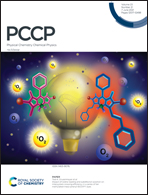MS-CASPT2 studies on the mechanistic photophysics of tellurium-substituted guanine and cytosine†
Abstract
Sulfur-substituted nucleobases are highly promising photosensitizers that are widely used in photodynamic therapy, and there are numerous studies exploring their unique photophysical behaviors. However, relevant photophysical investigations on selenium and tellurium substitutions are still rare. Herein, the high-level multistate complete-active-space second-order perturbation (MS-CASPT2) method was performed for the first time to explore the excited-state relaxation processes of tellurium-substituted guanine (TeG) and cytosine (TeC). Based on the electronic state properties in the Franck–Condon (FC) region, we found that the lowest five (S0, S1, S2, T1, and T2) and six (S0, S1, S2, T1, T2 and T3) states will participate in the nonadiabatic transition processes of TeG and TeC systems, respectively. In these electronic states, two kinds of minimum and intersection structures (i.e., planar and twisted structures) were obtained for both TeG and TeC systems. The linearly interpolated internal coordinate (LIIC) paths and spin–orbit coupling (SOC) constants revealed several possible planar and twisted excited-state decay channels, which could lead the systems to the lowest reactive triplet state of T1. Small energy barriers in the T1 state will trap the TeG and TeC systems for a while before they finally populate to the ground state. Although tellurium substitution would further redshift the absorption wavelength and enhance the intersystem crossing (ISC) rate to the T1 state compared with sulfur and selenium substitutions, the rapid ISC process of T1 → S0 may make it a less effective photosensitizer to sensitize the molecular oxygen. We believe our present work will provide important mechanistic insights into the photophysics of tellurium-substituted nucleobases.



 Please wait while we load your content...
Please wait while we load your content...